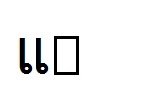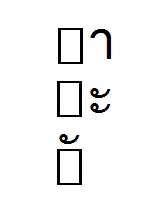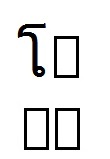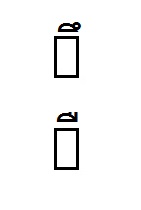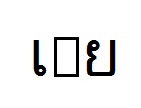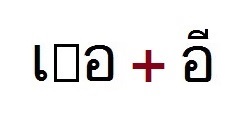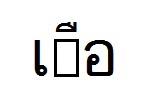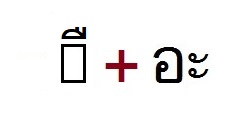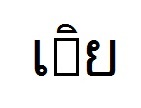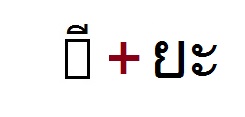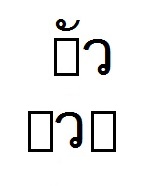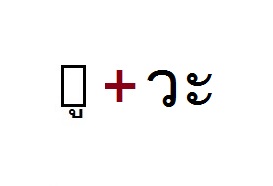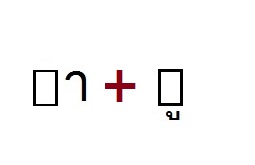Thai Language
So what about the tones?
It turns out that tones are almost a non-issue. Thais tend to speak in a monotone most of the time, no matter what the actual tone of the word is! (Read that again.) If you ask a Thai person (not a teacher) about tones, they will tell you that Thai is a monotone language. (Ask an English person if English is a tonal language… Heck, ask a Swedish person if they use tones also. Each person will insist that their language is spoken mostly in a monotone!)
Once you’ve understood what the tones should be (and if you master the tones ‘flow chart’ and make-subconscious the Four Questions (which you’ll get in the course), you can more or less ignore them. Tones DO need to be unmistakably expressed for certain words, usually where you pause for breath or where the word in the context of your conversation is ambiguous. You will eventually get to know the rhythm and musicality of Thai when you listen to full sentences spoken at natural speed.
It’s much easier and less confusing not to think of the letters as high/middle/low class – because of the way tones are usually described (“high”, “mid”, “low”, “rising”, “falling”). There is absolutely no one-to-one correspondence between the class and the tone. So a high letter will not give you a high tone, and so on.
It helps to convert the class definition that you learnt to the Rapid Method’s terminology (girls, boys and ladyboys), NOT the other way round. Please trust me on this. I spent five years not being able to speak Thai properly because I misunderstood how to correctly pronounce the tones in trying to follow the concept of high/falling/rising/etc. Very few Thai people could understand me, even though I was speaking relatively fluently. As far as they were concerned, I was speaking Whale!
This has been the experience of many people who can read and speak fluently but still think of tones in frequency terms (high/low/rising, etc.) Indeed, a few already-fluent people have attended my workshop primarily to deal with this issue.Although the frequency graph does sort of represent the sound of each tone, it is not only quite inaccurate, it is highly misleading and almost useless when it comes to real speech. When I listen to people speak and pay attention to how I feel when I speak, I notice that people nearly always drop their voice, regardless of the tone – unless they’re asking a question or using one of the polite endings like ครับ or คะ. The real indicator is the energy that’s exerted in making the sound, not so much the tone/frequency.
Here are the tones according to the Rapid Method:
The ‘uncertain’ or ‘surprised’ tone is spoken with a kind of a squeaky sound, however. It helps to physically scrunch up your face and eyes, like when you’re saying “what!?” in a surprised, sceptical, I-don’t-believe you tone. Yes, it’s kind of high-ish in sound; but it’s better to think ‘surprise’ because then the sound will come out right naturally. (The primary aim of this approach is so that you make the correct sounds naturally.)
The ‘question’ tone is more of a from-the-belly sound. It helps to physically place your hand on your belly as you say this sound (there’s lots of belly-holding and fist-shaking and face-scrunching in my system, which helps to produce the correct sounds naturally). Use these physical tricks. When you think in terms of the conventional, linguistic terminology (‘high’, ‘falling’, etc.), the very act of engaging your brain is like a spanner in the works: it stops the right sound coming out and contorts the sound.
To make a ‘question’ tone, I usually preface the word in question with “Are you …?” (“Are you fine?” = “Are you สอง?”) and the tone usually comes out right.
Same with the ‘surprise’ (aka ‘uncertain’) tone: start with “Is it really a …?” (“Is that really a rat!?” = “Is that really a รัก?” or “Is that really a ร้าน?) This is a difficult tone for us because it’s so similar to the ‘question’ tone and if you’re a bit lazy or thoughtless then you will usually make a ‘question’ tone. You really need to pause a fraction of a second and think “what!!??” (sometimes even a longish sound: “whaaaaat!!??”) while scrunching up your face.
As for the ‘exciting’ or ‘emphatic’ or ‘energetic’ tone, just make a fist and say “Yeah!!!” ข้าว แก้ว etc. This is easy for us, but you do need to exert a lot of energy (and, yes, you can allow your voice to fall when you’ve expended the energy). However, it does feel a bit silly because you have to express genuine enthusiasm. In fact, if you’re not feeling silly then you’re probably not saying it right!
The ‘boring’ or ‘no tone’ is very level and deadpan: don’t speak with any inflection at all, and stretch out the sound a little while keeping it flat and monotonous. Your voice will fall naturally when you’re done. (Which is why the term “falling tone” is a complete misnomer.) The ‘sad’ tone is the same, but with your shoulders drooping a little as in (the second word): “Uh ohhh….” or “Oh dear…” (And, as to be expected, there probably won’t be any further falling off of your voice because you have already fallen as far as you can go. What you’ll get instead, is a kind of pinched sound to finish, like snuffing out a candle with your fingers.)
In the Rapid Method there are therefore the two question tones (‘belly question’ and ‘surprised’), the two deadpan monotones (‘no tone’ and ‘sad tone’) and the exciting or energetic tone.
If you’ve already internalized the conventional tone terminology then please use the following conversion table in all your thinking about tones in future:
| Rising tone | belly question | hand on belly – why? how? |
| High tone | skeptical/surprise | scrunch up face, what!? |
| Falling tone | energetic/exciting | make a fist – yeah! (exert a lot of energy) |
| Mid tone | deadpan, robotic | talk-like-a-robot – dead pan, flat, lingering, monotonous |
| Low tone | sad, robotic | drop your shoulders – oh dear…. (feel depressed) |
And then never even think in terms of rising/falling etc. again. When we speak Thai, to a Thai person, it’s probably the same experience that we native English speakers have when we listen to Singaporeans speak English. They speak English fluently and clearly, but always a bit off; and it takes extra concentration and several repeats before one can understand what they’re saying.
Now, to confuse the issue even further: most of the time, one doesn’t even change the intonation when speaking colloquially at natural speed anyway! Most words are run together as a stream of monotonous sound. The tricky bit is to know when it’s necessary to express the tone, and a good rule of thumb is to do so only when you pause for breath.
The Four Questions
The best way to figure out the tones is to work through the following mental process over and over again until it becomes second nature. You will ask yourself 2, 3 or 4 questions to figure out the tone:
QUESTION
1. IS THERE A TONE MARK?
YES
a. Surfer tone mark → 2. What is the sex?
boys & girls are exciting (yeah!),
ladyboys are uncertain (what!?).
b. Dagger tone mark → 2. What is the sex?
ladyboys are exciting/melodramatic (yeah!),
boys & girls are low/sad.
c. Bowtie tone mark → always uncertain (what!?)
d. Plus/Flag tone mark → always question (how?)
WHEN THERE IS NO TONE MARK:
2. What is the sound ending of the word?
Does it Sing? →
3. What is the sex?
girls are question tone (how?),
boys & ladyboys are no tone.
Is it Dead (or cut off in some way)? →
3. What is the sex? -> boys & girls are low/sad;
But for ladyboys,
4. look at the vowel →
short/thin vowel is uncertain tone (what!?),
long/fat vowel is exciting/melodramatic (yeah!)tone
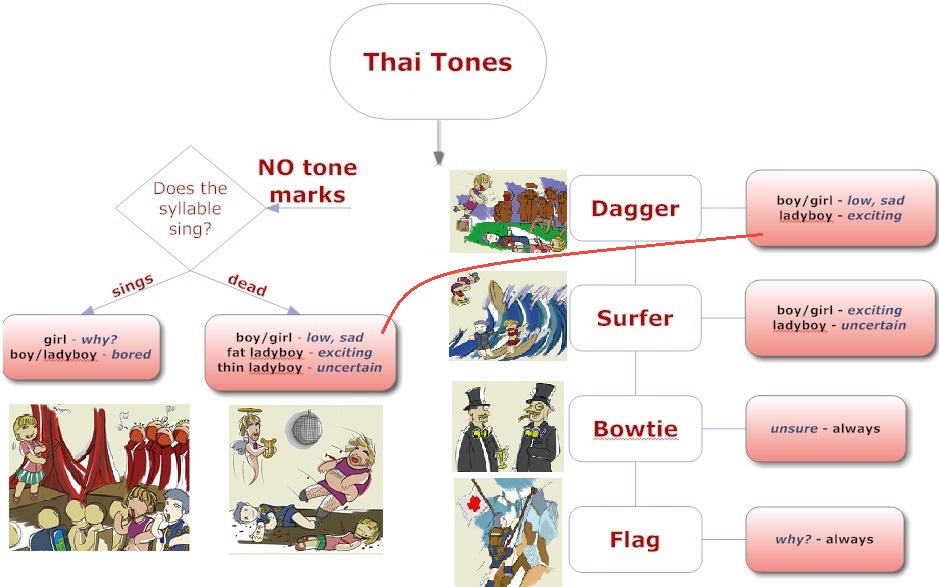
Modern Fonts
As for the modern fonts, if you can more or less recognize the classic fonts, with all the loops in the right places, you are probably ready to have a go at recognizing the more stylish, minimalistic modern fonts.
Most of the letters are the same, with bulges or blobs where the loops (heads) were. And if something isn’t important then it’s simply left out. For example, ม and น and ห don’t bother with the “head” (the loop on the top left). The main distinguishing factor is where the loop changes – e.g., for ม it’s on the bottom left, for น it’s on the bottom right, for ห it’s on the top right.
You’ll get to recognize these very quickly. Sometimes if you’re not sure about a particular letter because it could be one of two possibilities (e.g. the ด letter, which could be either ด or ถ in a modern font) then you might have to find another example of the letter, or its counterpart, in the text (hopefully it’s a long enough text to contain more than one example of the same letter).
Sometimes you’ll see a word you recognize – and by a process of deduction you’ll figure out what the letter is. It takes a bit of practice, but after a while you’ll find that the modern fonts are actually easier to read. They’re cleaner and have fewer distracting lines and loops than the classic fonts.
Obviously, it also helps to have some vocabulary so that you can more or less guess what the word is likely to be from the context.
Below is a table that identifies the differences that you do need to know in order to be able to read the modern fonts. The letters in black are easily recognizable in the modern fonts, so just focus on the red and blue letters.
Consonants

(For “snaggle-tooth” letter ธ refer to “rolling” ร below…)
The traditional fonts are in the left column. The next columns are the modern & handwritten forms. All that has happened is that the unimportant bits of the letter are left out, usually the extraneous loops. If you look at the 3rd & 4th letters down (ม and น) you’ll notice that the essential difference between these is the loop at the bottom is either on the left of the right. So the loop on the top left can be discarded. No other letters looks like these, so it’s safe to do so.
Note that when  has no indentation, it defaults to the ladyboy version.
has no indentation, it defaults to the ladyboy version.
Clearly  is looking inwards, showing that it is the girl version.
is looking inwards, showing that it is the girl version.
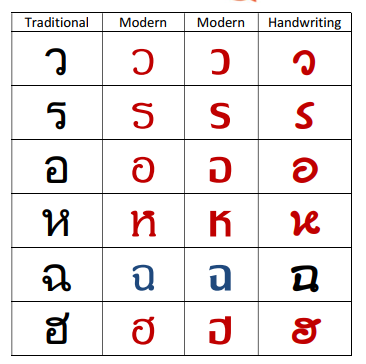
Some letters look quite different – and I’ve highlighted them in red. Some are only slightly different – and these are in blue. The blue ones just need to be noted and you’ll recognize them easily.
The red ones can be understood when you know how Thai letters are written. They start from the main loop. So the letter ว is written starting from the loop at the bottom. In English, we’d normally write it starting from the other end. Try writing it the Thai way. Now write it again, but very fast. And again, dropping the loop. And again. Notice that it starts to look like a lazy backwards “C”. So a good way to help you get from “c” to “w” is to think of “WC” – but backwards!
But keep in mind that it’s not always “w” – this is a tricky letter because it can be a vowel or a consonant, so make sure to spell out the idea in “long hand” in your mind: The waving ladyboy on her head shouting “ooh aah”… (In fact, even in English, the “w” is treated as a consonant but produced by making the “oo” vowel sound very quickly.)
Remember, all Thai letters are written starting from the loop. So what looks like an “S” is actually the ร written very quickly from the bottom, which eventually looks like our “S”. Think of a snake rearing its head to give you the “r” letter.
The backwards “G” is actually the อ written quickly or stylistically. Very often, you will see it simply as an “O”.
Note: ข is often identical in shape to บ but just a little thinner.
ช and ซ are very similar, it’s sometimes hard to see “slice” (the extra dent).
Finally, the “U” is simply the u-boat บ and the upside down “U” is the male chicken without its beak ก.)
Vowels & Tone Marks
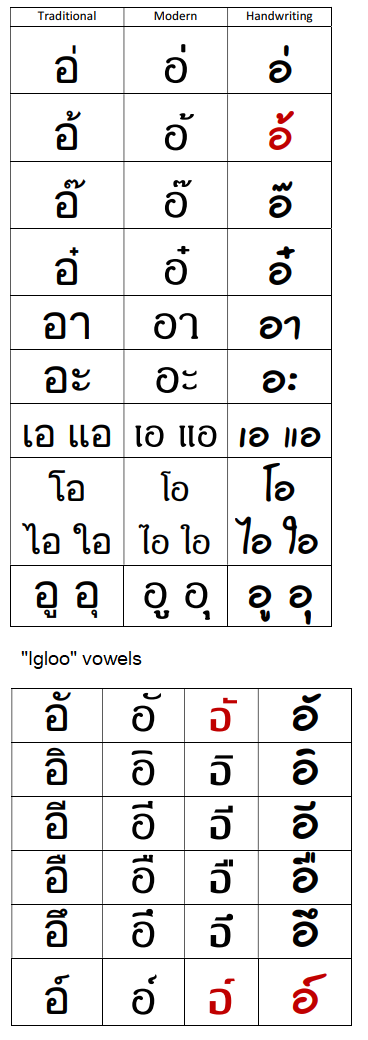
As for the vowels, they’re mostly easily recognizable in any font.
However, there are two or three vowels that are potentially confusing. The modern font for “puppy pizza topping” seems very similar to the “igloo” vowels. But by a process of elimination, it’s the only one that has a stroke or bulge on the left side, while all the “igloo” vowels have some kind of feature on the right (or nothing at all for the plain “igloo” vowel).
Also, the “puppy pizza topping” vowel is sometimes confused with the “surfer” tone mark. Notice that the latter mark is more of a zig-zag, like a “2” or “Z”.
And the “gag duct tape” could also sometimes be confused with the “surfer” tone mark. Notice which way it rolls. Besides, it’s easy to guess from the context that it’s likely to be a silent letter underneath than one with a vowel or tone mark on top.
And that’s it, it’s really that simple!
(BTW, if you haven’t learnt to read with the Rapid Method then you won’t understand my reference to “puppies” or “chickens” or “ladyboys”, etc. in the notes because I’m referring to the terminology I’ve invented for teaching people to read Thai using an accelerated approach. You can still figure out how to recognize the modern fonts from the tables above.)
Why learn Thai?
Well, actually, you don’t need to learn Thai at all!
There are enough people who can speak or understand English – even (or especially) in business – that you can get by and live quite successfully in Thailand… for many years. Some expats have been here for 10 or 15 years and own or manage successful businesses, without speaking more than a smattering of Thai.
Besides, Thai is quite difficult and boring to learn – that is, if you go to a ‘traditional’ class or try to learn it the way it is conventionally taught.
The way the tones are explained is quite confusing (when in fact, we use the same tones in English), and the transliteration schemes are non-standard and inconsistent. And there are around 40 consonants, several for the same sound (4 for “s”, 4 for “t”, 3 for “k”, etc.) and about 20 vowels and a dozen extra symbols. Not to mention some letters that can be used in several different ways, depending on the context.
It’s not as if Thai is a world language, like Spanish or French or Chinese or even Hindi, or a useful one for business or travel. Nor has it a wealth of literature, making it worth learning so as to read great works in the original, like Russian or German or Japanese.
Thai is more of a ‘lifestyle’ language, like Italian or Swedish – great if you want to enjoy living here, but otherwise not especially useful for world travelers or business people.
So why bother?
Well, once you can read, everything begins to fall into place naturally. You start to absorb the Thai language from your surroundings, from the street signs and notices and menus – without any effort and without having to spend time studying. You are surrounded by a ‘living dictionary’…
It makes learning to speak and communicate in Thai so much easier too. You know how to say things right, so you begin to hear what people say more clearly. You can learn from Thai songs, stories and interesting self-help books or biographies (where the writing style is surprisingly colloquial). It’s a lot more fun than sitting in a class learning grammar.
It is not at all important to learn to write Thai! Don’t waste your time, don’t attend “writing” classes. Use your computer to type instead. After all, Typing is Reading!
Becoming literate in Thai is the crucial first step for speaking Thai, and eventually becoming a fluent communicator… (by ‘fluent’ I mean not having to think about the language when speaking).
Being able to speak Thai opens up the world for you in Thailand. The girls (and guys) will flock to you in admiration. Many Thai people are shy, but they will be attracted to you if you can converse in Thai. Even if they know some English, they prefer to be able to fall back on Thai, especially if they want to hang out with their friends as well.
It’s also good for business, even if you are in an English environment. You will have a better idea of what your staff and colleagues are thinking and be able to get your ideas across more directly – and accurately – than if you rely on bilingual go-betweens. If you work in a school or environment where it’s all Thai then you won’t be so isolated and will start to make friends amongst your colleagues and their friends more readily than before.
And you’ll be surprised at how much more cheaply you can live in Thailand once you can read and communicate in Thai. You can rent an entire house for the same price as a small room in an ‘expat’ area. I won’t tell you what I paid for my 6-room house in Bangkok and my country-house-with-garden in Chiang Mai, it’s too embarrassing! You can swan around Bangkok on buses and vans (that get to where you want to go just as quickly as the taxis). You will easily save several times more than the cost of the course.
Ultimately, living in Thailand is so much more fun when you can speak and understand Thai. Instead of being cloistered in the safe-but-dull ‘farang-friendly’ zones, you can discover the hidden byways and clubs and organizations normally reserved only for Thais. You have the freedom to go where you want and with whom you like. And you can make friends with anybody if there is no awkward language barrier.
Expats – Speaking Thai (not!) in Thailand
Thai is difficult to learn. Or is it?
The main trouble is that learning Thai is super boring and fiendishly difficult…!
Learning any language usually requires hundreds of hours of investment in time and effort. There are better things to do in life! Learning an obscure language like Thai isn’t one of them.
So why bother to learn Thai?
Nevertheless, there are subtle but significant advantages to being conversant and literate in Thai. The first quite simply is feeling confident about going out anywhere in Thailand without ever being afraid of getting lost!
The other is that you start to notice and understand and appreciate a ‘parallel world’ that is real Thailand – and you can start interacting with Thai people in a more personal way.
Is there an easier way?
 |
There is a way to start becoming fluent in Thai without spending too many hours in a dreary language class. As a non-linguist who has found it difficult to learn languages in the past, I’ve developed a ‘Rapid’ approach. I’ve simplified Thai – by throwing out anything that is superfluous, and then I’ve found ways to use what we already know and what already comes naturally to us. For instance, what’s known as the ‘rising tone’ in Thai is simply the tone we use naturally when asking a question: “Are you fine?”… “Are you saam? [three]” |
The ‘Rapid’ Method
My aim as the owner / author / developer is to find the most convenient, most enjoyable and most effective way to learn Thai.
In the case of learning to read Thai – an essential first step – it takes no time at all if you do it intensively. But I’m otherwise not really interested in intensive and ‘quick’ ways to learn. These methods usually involve taking time away from your work and social life and studying all day, every day, over several weeks or months.
I’m sure that you have a life! And no doubt you are also not the kind of person who gets pleasure out of reading a dictionary from cover to cover as bedtime reading…
The ‘Rapid’ method is designed to require as little time and effort as possible – and the little studying that is required must be as enjoyable as possible in its own right.
So if you don’t want to take off a weekend to attend a workshop – or devote two whole afternoons to follow the Read Thai in a Day ebook – then you can follow the course leisurely as part of your daily coffee break, 15 minutes a day… This is the laziest way, yet it is extremely effective. By the end of two months, you will be literate!
One man shamefully admitted that he had lived in Thailand for 8 years and still didn’t know how to even pronounce a single letter in the alphabet!
And my ‘fluency’ course is probably even more astonishing. Just one lesson a week (about an hour to 90 minutes) and 15 minutes a day for the remaining four days – and you will be able to speak fluently and understand 90% of an everyday conversation after about a year.* It takes most people 3-4 years of continuous, applied study at a Thai school at least twice a week to achieve the same level.
Read more about the Rapid Method here…

* This assertion is an estimation, which will be tested and tangibly measured in 2011. My definition of ‘fluency’ is to be able to speak naturally and at speed (but not always correctly) in an everyday conversation without thinking. You will not necessarily achieve high scores in academic measures of your linguistic skills. I also do not consider writing to be a necessary or desirable skill if you merely want to be a ‘fluent’ reader and conversationalist.
An American in Phuket
Well, not just Americans and not just Phuket – any ‘farang’ in Thailand has to decide whether to bother learning Thai or just get by with English-speaking Thai people instead.
Here’s an extract from an article in the Phuket Post, to learn Thai or not to learn, that is the question:
We all know what life is like for a farang… Pretty damn good if we are to be truly honest. Sure, there is the odd bit of stereotyping and discrimination involved in being white in Phuket, I mean we’re all not here as sex tourists or here to exploit a cheaper workforce in order to profit ourselves are we? Some of us are here because we enjoy the lifestyle, the beaches and the food. Some of us take steps to become integrated into Thai society. Don’t we? Don’t you?
Even if you don’t then you’re still unlikely to experience many problems. You can re-create your little Western existence in Thailand without having to even acknowledge you are in a foreign country or even a foreigner.
Farangs in Phuket can go and watch a movie in English, read a menu in English, give directions to a taxi driver in English, chat up a girl in English and then go home and eat English food (although not sure why anyone would). Farang culture permeates the seams of Phuket. So, you’re not a foreigner really are you? You’re a farang!
… Moazamm admits that when he first arrived in Thailand it was difficult, partly owing to the language barrier. He therefore quickly made it his priority to learn it. “When Thai people see me, they treat me differently, [but] when I speak Thai that changes and they become less cautious and more friendly.”
For Moazzam, learning the native language was an absolute necessity in order to not only prosper in the business world, but also in his private life. Moazamm is married to a Thai woman with whom he has had children with. This perhaps explains why he believes, “I don’t really feel like a foreigner, well I feel about 30% foreign, as this is my home now. I am immersed in Thai culture.”
… But one thing that Aorn, Moazzam and our tailor have in common is that they all believe that if ‘new arrivals’ learn the language, then their experience will be much less segregated and more accessible.
[original article no longer exists]
The Male Sex-Change Doctor
There are only four/five words that use the อ sex-change doctor, all of them starting with ย.
| อยาก | to want (to do something) | “dead boy” – sad tone | |
| to live/reside, to be at (a place); to be happening continuously (-ing) | “singing boy” – boring, no tone | ||
| don’t | “dagger on boy” – sad tone | ||
| type, kind, sort, a quality of an object or person; as, like, in the way of… (changing an adjective to adverb as in -ly) | “dagger on boy” – sad tone | ||
| how; whichever (usually written informally or spoken as ยังไง) |
Get to know them because then for all other words spelled using อ, it can only either be:
- a silent consonant “placeholder” for any vowel that is attached to it
- the “awe” vowel if attached to the right side of any consonant.
When a vowel is attached to it then it just becomes the sound of the vowel. The อ letter itself is silent (actually, it’s the “glottal stop” so that you can launch into the vowel sound):
When it’s attached to the right side of a consonant then it is the “awe” vowel:
รอ บ่อ นอน
The only time it can be potentially confusing is when it’s a two-letter word with the invisible or implied “o” vowel in-between; or when it’s fused together with another consonant, making it unpronounceable as it stands:
| chest | invisibe “o” vowel: “ok” | |
| bake; to scent/perfume | invisibe “o” vowel: “ob” | |
| to go without, miss, refrain | invisible “o” vowel “od” | |
| suck, keep in mouth; hide; embezzle/cheat | invisible “o” vowel: “om” | |
| organ, body part | invisible “o” vowel: “ong” | |
| delicious | spacer “a” vowel: “a-roi” | |
| grape | spacer “a” vowel: “a-ngun” | |
| Asok | spacer “a” vowel “a-soahk | |
| to explain | spacer “a” vowel: “a-tibaai” |
In general, except for the top five 2-letter words, which are single-syllable words, if you see อ as the first letter of a multi-syllable word and no vowel written then it is most likely to be the spacer “a” vowel.
English is a ‘Tonal Language’ – surprise, surprise!
In Chiang Mai, a woman came to the course who could already read after a fashion and speak fairly fluently – but she came because she had a great deal of confusion about the tones, and so never bothered to “read the tones” – previously she simply tried to recognize the tone from memory of her spoken Thai.
The ‘Rapid method’ clarified the whole issue for her.
The main confusion, I think, is that the ‘Thai method’ uses the same terminology for classes and tones: high tone, high class – mid tone, middle class – low tone, low class (plus rising and falling tones)…
There is absolutely no relationship at all between the class and the tone!
Letters have sex!
That’s why I created a completely different way to classify the consonant classes:
- ladies (for high class, because they are higher class creatures!!!)
- ladyboys (for low class, because they are kind of lower class riff raff – not politically-correct and certainly insulting, but then this mnemonic is only for those who’ve already learned the ‘class system’); and
- boys who are very simple non-descript creatures and who kind of float (fart) around in the middle…
English Tones
I also changed the tonal system – it may be technically accurate to describe them as high/low/falling/rising (in terms of tonality), but no native speaker ever thinks like that. When we ask a question, for instance, we never consciously make a rising inflection. It just happens naturally. Similarly, a Thai person never thinks: “Because the word ‘three’ has a rising tone, I have to deepen my voice and allow it to rise to a reasonably high squeaky pitch…”
So here is how to say the (four) Thai tones correctly using ‘English tones’:
- The so-called “rising tone” is our question: “Why?”
- The so-called “high tone” is when we ask a question while feeling unsure or skeptical: “Are you sure?” “Is that the new iPad?”
- The so-called “falling tone” is our emphasis or excitement: “Yeah!”
- The so-called “low tone” is our sad or relaxed feeling: “Oh dear….”
And I don’t like to refer to a 5th tone, but it could be considered a flat, boring, monotonous sound as in the shipping forecast!
That’s all there is to it.
Tones the ‘Thai’ Way
Tones are actually dead simple in Thai.
At least, it should be. Unfortunately, the traditional Thai system seems arbitrary and overly complicated, and the terminology is unnecessarily confusing (e.g. high class / high tone), which leads one to assume that there must be some matching relationship between class and tone.
Well there isn’t! None at all.
There is also a great deal of irrelevant information that has to be learnt… For example, for two of the tone marks, the class of the letter is irrelevant. And in general, it does not matter how long or short the vowel is, except in one special case. You also don’t need to know about initial and final consonant sounds, nor the actual names of the letters, etc.
The Rapid Method
Less is more.
My ‘Rapid’ system is designed around the absolute minimum amount of information required (on a need to know basis) to be able to read easily and accurately. And as often as possible, I’ve wrapped up the information in stories and pictures in such a way that several linguistic elements can be conceptualized as a single, easy to remember unit.
| For example, both boys and girls are sporty, so they can surf down the wave with ease “yeah!” – this is one item of information, but it represents two separate combinations in the traditional Thai tone table; and the whole concept of the surf mark is wrapped into a single picture story so that you conceptualize the surf mark as a single unit that plays out in your mind like a short youtube movie)! |
The Conventional Thai Consonant / Class Tone System
If you learn the tone system the conventional ‘Thai way’, you would be required to memorize and understand the consonant class tables below:
For syllables with a tone mark, the following rules apply:
| Tone Mark | Class | Tone |
| known as ไม้เอก | low mid/high |
falling low |
| known as ไม้โท | low mid/high |
high falling |
| known as ไม้ตรี | (any) | high |
| known as ไม้จัตวา | (any) | rising |
For syllables without a tone mark, both the initial consonant class and whether it’s a ‘live’ or ‘dead’ syllable are important.
For ‘live’ syllables without a tone mark, the tone rules are (relatively) simple:
| Initial Consonant Class | Tone | |
| low/mid | middle | |
| high | rising | |
But for ‘dead’ syllables, you need to be aware of whether the vowel is short or long:
| Initial Consonant Class | Vowel | Tone |
| low | short long |
high falling |
| mid/high | (either) | low |
It’s a bit complicated, right?
Having to keep all this mind when deciphering each word is quite a complicated mental juggling act. This slows down your reading quite considerably.
Nevertheless, if you put enough effort into it then you can memorize these rules, along with the class each consonant belongs to.
Or you can dispense with these tables entirely by doing it the ‘Rapid’ way, which is simpler and hence quicker and easier.
How Thais (and Asians) pronounce their “R”s and “L”s
In the European languages like English, German, Italian, French and Spanish, the sounds for “L’ and “R” are quite distinct. This is because the position of the tongue is either at the extreme front end of the mouth (pushing quite forcefully against the top teeth) for the “L” or at the general back part of the mouth for the “R”. The French “R” is with the back of the tongue almost being swallowed at the back of the mouth, while the German “R” is vibrated very vigorously in the middle of the mouth. The English “R” is produced with the tongue floating just beneath the palate towards the back of the mouth.
So the “L” is a very different animal from the “R” because the “L” is a strong tongue-pushing-at-the-front sound and the “R” is a vibrating or rolling tongue sound nearer the back.

However Thas (and Asians in general) produce an “L” by positioning the tongue very lightly against the palate well behind the teeth just in front of the middle of the mouth.

While the “R” is in the same position but with the tongue allowed to drop a little so that it “floats” ever so slightly below the palate.

The Asian “R” becomes an “L” simply by touching the palate with the tongue.
That’s why L and R sound so similar to our Western ears – because they are very similar. And when Thais (and Asians) speak a little lazily, or fast – which is usually the case – when pronouncing “R” it’s usually easier to let the tongue touch the palate instead of leaving it “float” just below it – which results in an (Asian) “L”.
At the end of a syllable, Ls and Rs aren’t fully enunciated. Instead you simply close down your palate and push your tongue down. The resulting sound is very like our English “N”.
That’s why อาหาร and บิล are pronounced “ahaan” and “bin”, respectively (not “ahaar” and “bill”).
Pronouncing the Vowels
It is absolutely essential to pronounce the vowel sounds accurately in order to be understood.
Thankfully, the vowel sounds in Thai are very consistent, they do not change depending on your region, as in English. There are regional dialects in Thailand, of course, but if you pronounce the vowels in particular the ‘standard’ (middle-country) way then you will be universally understood.
There are only nine vowel shapes in Thai. All the vowels are made up of short (cut-off) or long versions of these sounds, or of two vowel sounds pronounced in sequence (“dipthongs”). This article is a summary for your reference and practice.
If you haven’t already watched the videos on youtube then watch them now.
| Exaggerated ‘farang’ version and explanations | The normal Thai way of pronouncing the vowels |
HERE ARE THE NINE SHAPES.
Practice them in an exaggerated way until you develop a muscle memory for the feeling of each shape. Stretch your muscles so that they feel tired after a minute or two (otherwise you’re not doing it right)! It may feel a bit silly to talk in such an exaggerated potato-in-mouth way (in fact, it should!) but it’s normal for Thai people, just like it feels quite normal and natural for us to stick our tongues out when pronouncing “th” in English. We need to train our mouth muscles so that these shapes eventually feel normal and comfortable if we want to be able to enunciate Thai clearly.
If a Thai person compliments you by saying พูดเก่งนะ then they’re just being polite:”hey, good effort (but I still don’t understand you)!” However, if someone says พูดชัด then you know you’ve arrived:you speak clearly enough that they can actually hear what you’re saying.
VOWEL/SHAPE COMPARISONS
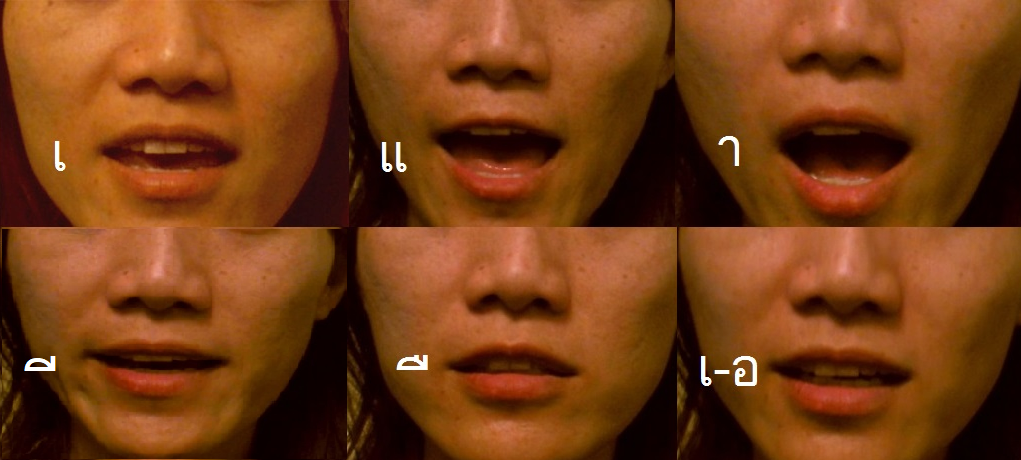
The “spacer” or “bridging” vowel
Basically, for two-letter words with no vowel, the vowel is understood or implied to be the short “o” vowel. (It’s not the “o” as in “on” and it’s not the “o” as in “no”. It’s the short version of the vowel in “short”. The closest equivalent in English might be the “augh” sound in “naught”. Or if you say “o”in “or” and cut it really short then that will be the sound you want.
So here are some examples that you can probably already recognize:
– ผม – I (for a male)
– หก – six
– สด – fresh
– ตด – fart
– หมด – used up; completely (note that ห is just used to change the sex of ม, it makes no sound of its own)
The last one is still a “two-letter” word! The ห is just there to change the sex of ม from a ladyboy into a girl. Another way you can think of it is that the first consonant (reading from left to right) is what determines the “sex” of the entire syllable.
Now what about the multiple syllable words?
Well, strictly speaking, they’re still single syllable words. These are usually foreign-derived words (from English or Pali) that cannot be easily pronounced by Thais – like “stamp”. So they add a kind of “spacer” or “bridging” sound… an “a” (like the “a” in “pizza” or the “u” in “up). So “stamp” becomes “s-a-tamp” and “steak” becomes “s-a-tehk” and “tnon” (street) becomes “t-a-non”. (Can you say “tnon” as a single syllable???)
So if there is no vowel written anywhere in a 3- or 4-letter word then very likely it’s one of those words that have two consonants fused together like Siamese Twins in the beginning and then the invisible “o” vowel in the middle.
ขนม is a good example of this.
This is actually the two letters ขน fused together to form the unpronounceable sound “cn” followed by an ม. So as there’s no vowel written, it’s the implied “o” sound. And the word – which should be “cnom” becomes pronounced as “c-a-nom”.
There are several examples of this in Thai, where two fused-together letters are “spaced out” by inserting a short “a” sound, like:
– ตลาด tlaahd = t-a-laahd
– สวัสดี swas dee = s-a-was dee [s signifies that the “s” isn’t enunciated, so sounds almost like a strangled “t”]
– สบาย sbaai = s-a-baai
In all other cases (where two consonant letters are fused together), you can either say them as written or – very often in colloquial speech – simply drop the second consonant entirely, as in :
– ครับ krab or kab
– ปลา plaa or paa
How to pronounce องุ่น
There are several words that start with อ fused together with another consonant letter. So how do you pronounce a silent letter with another consonant letter?
Well, it’s the same as any two ‘unpronouncable’ fused letters. You must open your mouth wide to jump from the first sound to the second, i.e. by making an ะ sound.
So องุ่น is pronounced อะ-งุน, just like is สบาย pronounced สะ-บาย or ขนม is pronounced ขะ-นม.
Obviously, there are a few two-letter words that start with อ and have no vowel (in which case it’s the invisible or default ‘o’ vowel), like อก (chest/breast), อม (to suck), อบ (bake), อด (refrain from) and องค์ (organ/bodypart).
And don’t forget the four words where อ changes the ladyboy (ย) back into a boy for tone purposes:
อย่า
อย่าง
อยาก
อยู่
Note: For tone purposes, it’s the first consonant that determines the sex of the word (or compound syllable in this case). But also note that this only applies if the second consonant is a ladyboy (which it is, most of the time, anyway)…
So องุ่น is a dead boy (sad).
ขนม is a singing girl (question)
But in สบาย, the second consonant in the fused pair is a boy – so we don’t give precedence to ส and so the sex for the whole thing is a boy: บ (i.e. singing boy = no tone).
More notes about the รร (“run”) vowel.
On its own รร is pronounced like the English word “run”.
But it will never appear on its own.
1. Normally it will be surrounded by two consonants, in which case it simply becomes the “puppy” vowel, as in ธรรม, pronounced ธัม (dharma) or กรรม, pronounced กัม (karma).
2. Occasionally there will just be a consonant on the left and none on the right, in which case, the final “rolling ladyboy” becomes a kind of “n” at the “end”, as in บรร-ทุก (บัรทุก = truck)
3. Conceivably, there could be a consonant on the right only and none on the left, in which case it would become รั-, but I haven’t come across any words spelled this way.
This spelling is used in a few very common words, so unfortunately, one can’t just discard it as being too obscure:
| รถ บรรทุก | truck |
| สุวรรณภูมิ | Suvarnabhumi (pronounced “su-wan-a-phoom” in Thai) |
| ธรรมดา | ordinary |
| ธรรมชาติ | nature/natural (the final “igloo” vowel isn’t pronounced) |
| and | |
| กิจกรรม | activity |
| บรรจุภัณฑ์ | package |
| วัฒนธรรม | culture |
| พฤติกรรม | behavior |
Reading Modern Fonts
If you can more or less recognize the classic fonts, with all the loops in the right places, you are probably ready to have a go at recognizing the more stylish, minimalistic modern fonts.
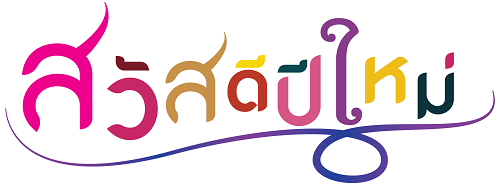 |
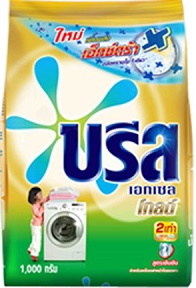 |
Modern Fonts are actually quite easy to read, once you get used to them.
Please download this PDF handout to see how the fonts differ (or not, as the case may be).
Most of the letters are the same, with bulges or blobs where the loops (heads) were. And if something isn’t important then it’s simply left out. For example, ม and น and ห don’t bother with the “head” (the loop on the top left). The main distinguishing factor is where the loop changes – e.g., for ม it’s on the bottom left, for น it’s on the bottom right, for ห it’s on the top right.
You’ll get to recognize these very quickly. Sometimes if you’re not sure about a particular letter because it could one of two possibilities (e.g. the ด letter, which could be either ด or ถ in a modern font) then you might have to find another example of the letter, or its counterpart, in the text (hopefully it’s a long enough text to contain more than on example of the same letter).
Sometimes you’ll see a word you recognize, it becomes a ‘sight word’ – and by a process of deduction you’ll figure out what the letter is. It takes a bit of practice, but after a while you’ll find that the modern fonts are actually easier to read. They’re cleaner and have fewer distracting lines and loops than the classic fonts.
Obviously, it also helps to have some vocabulary so that you can more or less guess what the word is likely to be from the context.
Attached is the hand-out that identifies the differences that you do need to know in order to be able to read the modern fonts. The letters in black are easily recognizable in the modern fonts, so just focus on the red and blue letters.
- The traditional fonts are in the left column. The next columns are the modern & handwritten forms. All that has happened is that the unimportant bits of the letter are left out, usually the extraneous loops. If you look at the 3rd & 4th letters down (ม and น) you’ll notice that the essential difference between these is the loop at the bottom is either on the left of the right. So the loop on the top left can be discarded. No other letters looks like these, so it’s safe to do so.
- Sometimes the ห looks more like a K than an H or h. But if you think of the K as a kind of h but with the dash (representing the ‘baby’ of the hump-backed mother) then it’s easier to recognize.
- Another potentially confusing letter is the ข (cackling old witch). It’s often just a skinnier version of บ or sometimes a kind of lazy V. But it can also sometimes look like a cursive X
 . If you write it very fast and lazily, the curl of her neck can easily intersect and become like an
. If you write it very fast and lazily, the curl of her neck can easily intersect and become like an  .
. - The ช and ซ are often quite difficult to distinguish, either from the regular ข or from each other because the dent of the ‘chop’ is often very slight, and the dent in the ‘slice-and-dice’ neck is usually a hint of a curve, no more.
- Some letters look quite different – and I’ve highlighted them in red. Some are only slightly different – and these are in blue. The blue ones just need to be noted and you’ll recognize them easily. The red ones can be understood when you know how Thai letters are written. They start from the main loop. So the letter ว is written starting from the loop at the bottom. In English, we’d normally write it starting from the other end. Try writing it the Thai way. Now write it again, but very fast. And again, dropping the loop. And again. Notice that it starts to look like a lazy backwards “C”.So you could maybe think of it as a backwards WC or
.png) , which is how wiggly ladyboys use the lavatory anyway!
, which is how wiggly ladyboys use the lavatory anyway!
Another way to think of this is simply to “see” a different picture that represents the same sound (W) – the “wiggly” ear of a cartoon face…!
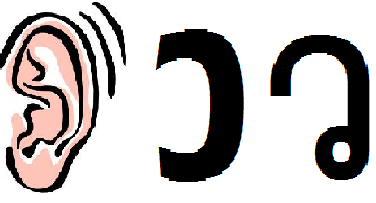
- Remember, all Thai letters are written starting from the loop. So what looks like an “S” is actually the ร written very quickly from the bottom, which eventually looks like our “S”. Think of a Snake Rearing its head to give you the “r” letter.

- The backwards “G” is actually the อ written quickly or stylistically. Very often, you will see it simply as an “O”.
- Finally, the “U” is simply the u-boat บ and the upside down “U” is the male chicken in the sky without its beak ก.
As for the vowels, these are mostly the same except for the following potential ambiguities:
- The ‘igloo’ vowels are fairly obvious: either a single horizontal dash for the “igloo”, a horizontal dash and a vertical line on the right for ‘chiminey’, two vertical lines for ‘birdy’ and a blob for ‘burp’. However, the ‘puppy/pizza topping’ has the vertical line or curve on the left.
- The ‘surfer’ tone mark and ‘puppy’ vowel can sometimes look the same. Keep in mind that the ‘surfer’ tone mark is actually a zig-zaggy character like a “Z” (actually the number “2”), whereas the ‘puppy’ is at most a slighly concave horizontal line.
- The เ and แ vowels are quite obvious, but often appear as two vertical lines, | or ||. And the ‘end-puppies’ ะ often appear as two dots like a colon :
Once you’ve become familiar with the ‘classic’ style of the letters, you’ll notice that It’s only a few letters that look ‘different’; the rest are more or less obvious.
Print out the handout (above) for reference and then see if you can make out the following signs:
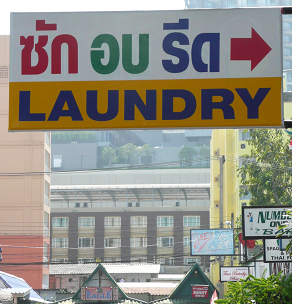 |
ซัก อบ รีด | |
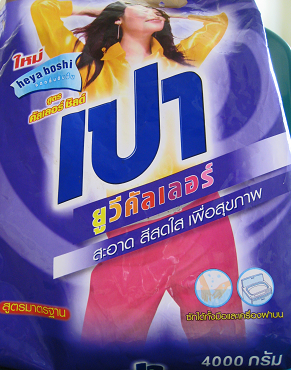 |
เปา ยูวีคัลเลอร์ สะอาด สีสดใจ เพือสุขภาพ 4000 กรัม |
|
 |
แว่นบิวตี้ฟูล | |
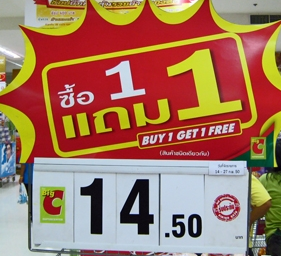 |
ซื้อ 1 แถม 1 | |
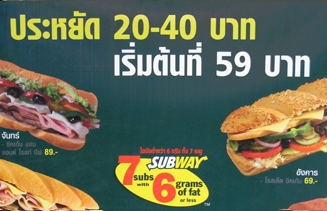 |
ประหยัด 20-40 บาท เริ่มต้นที่ 59 บาท |





